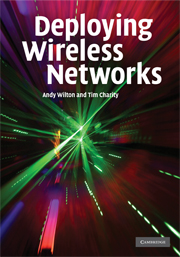Book contents
- Frontmatter
- Contents
- Foreword by Sir David Brown, FREng
- Preface
- Acknowledgements
- Authors' disclaimer
- 1 Introduction
- 2 Wireless network systems
- 3 Principles of access network planning
- 4 Introduction to RAN planning and design
- 5 GSM RAN planning and design
- 6 UMTS RAN planning and design
- 7 Cellular OFDM RAN planning and design
- 8 Mesh network planning and design
- 9 Core network and transmission
- 10 Network operation and optimisation
- Acronyms
- Index
- References
8 - Mesh network planning and design
Published online by Cambridge University Press: 13 August 2009
- Frontmatter
- Contents
- Foreword by Sir David Brown, FREng
- Preface
- Acknowledgements
- Authors' disclaimer
- 1 Introduction
- 2 Wireless network systems
- 3 Principles of access network planning
- 4 Introduction to RAN planning and design
- 5 GSM RAN planning and design
- 6 UMTS RAN planning and design
- 7 Cellular OFDM RAN planning and design
- 8 Mesh network planning and design
- 9 Core network and transmission
- 10 Network operation and optimisation
- Acronyms
- Index
- References
Summary
Principles of mesh networking
As discussed earlier, one method for increasing capacity in cellular networks is to make the cell sizes smaller, allowing more subscribers to use the available radio spectrum without interfering with each other. A similar approach is used in 802.11 (Wi-Fi) – either to provide public ‘hot-spot’ broadband connections or to link to broadband connections in the home via a Wi-Fi router. The range of such systems is limited to a few tens of metres by restricting the power output of the Wi-Fi transmitter. The goal of a wireless mesh is to extend the 802.11 coverage outdoors over a wider area (typically tens of square kilometres) not simply by increasing the power, but by creating contiguous coverage with dozens of access points (APs) or nodes, separated by distances of 100–150 metres. For such a solution to be economically viable, the access points themselves need to be relatively cheap to manufacture and install, and the back-haul costs must be tightly managed. To address this latter requirement, only a small percentage of APs (typically 10–20%) have dedicated back-haul to the Internet; the other APs pass their traffic through neighbouring APs until an AP with back-haul is reached. At the time of writing, the IEEE 802.11s standard for mesh networking is still being drafted, and various proprietary flavours of mesh networks exist. The following discussion outlines the principal characteristics and properties of most commercially available mesh networks, which will be embodied in 802.11s when it is finalised.
Information
- Type
- Chapter
- Information
- Deploying Wireless Networks , pp. 264 - 273Publisher: Cambridge University PressPrint publication year: 2008
